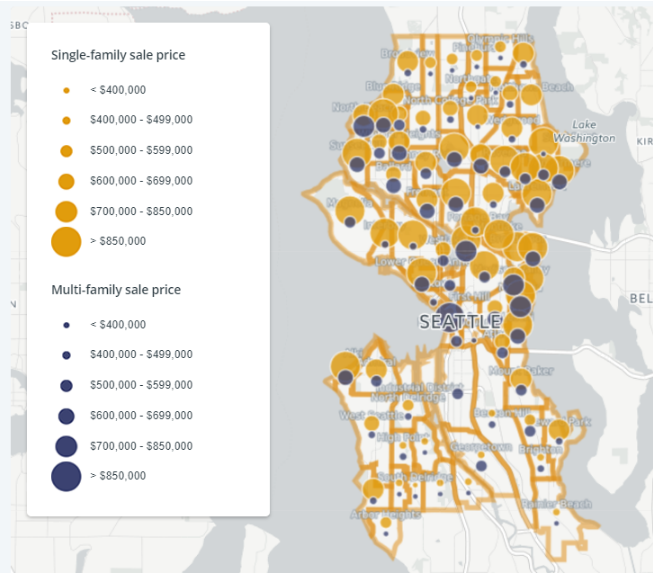Sightline’s Margaret Morales published a great piece yesterday using housing data to show that multi-family housing helps make Seattle neighborhoods more affordable. Detached single-family zoning, on the other hand, leads to a more expensive housing getting built or remodeled.
Proponents of detached single-family zoning sometimes point to anecdotal data (i.e., this particular townhome is expensive) to argue rezoning doesn’t work. Analyzing the data, however, shows categorically detached single-family homes are significantly more expensive–even if particular townhomes or condominiums sometimes seem expensive. In fact, multi-family homes were $220,000 cheaper on average than single-family homes, as Morales explained:
As the map shows, multi-family home sale prices are much cheaper than single-family home sales. In fact, across the city multi-family home sales averaged $220,000, or 30 percent, less than average single-family home sales over the last year. Even brand new multi-family homes, those built within the last 18 months, cost an average of $45,000 less than older single-family homes, those built prior to 2016. In other words, though the story of Devin’s home is happening in some parts of the city, that’s not the whole story. Multi-family homes are offering Seattleites cheaper homeownership alternatives to single-family homes.
Below is Sightline’s interactive map. The map tallies home sales by neighborhood between July 1, 2016 and July 1, 2017, which totaled almost 11,000. Almost 7,000 were single-family home sales–defined strictly to the detached single family home variety. “The other nearly 4,000 sales were multi-family homes, represented by blue dots,” Morales wrote. “This group includes condominiums, townhomes, rowhouses, and homes on residential small lots (RSL), like skinnies and four-packs, sometimes known as cottage housing.” For the land-use nerds out there, technically townhomes, rowhouses and duplexes are attached single family homes, but for the purposes of this study it makes sense to lump them together broadly as multi-family, since they do represent a step up in density.
https://sightline.carto.com/builder/8b858c82-a148-4df7-9bf9-cd8e380c0b77/embed
In Wallingford, multi-family homes sold for an average of $672,198, but single-family homes averaged $852,707. Upper Queen Anne saw an even bigger spread with multi-family homes averaging $494,630 and single-family homes averaging $1,143,926. Laurelhurst saw a mammoth divide with multi-family homes at $628,750 and the average sale price of single-family homes exceeding $1.7 million. The huge price tag of Laurelhurst single-family housing shows that the Laurelhurst Community Club efforts to block multi-family housing–whether intentional or not–is pulling up the drawbridge on the middle class and economically segregating the neighborhood.
I’ve proposed solutions to counteract Seattle’s million-dollar-mansion tendency. One idea is to ban the construction of new mansions by capping square footage like Portland did. Another idea–which is singled out as an high impact recommendation in the Housing Affordability an Livability Agenda (HALA) committee report–is to greatly expand the amount of land zoned for multi-family housing. More than half of Seattle’s parcel land is zoned for only detached single family homes, a very expensive urban housing type. The Seattle Department of Planning and Development estimated single family zones comprise nearly 65% or parcel land area–it depends how you measure but it’s clearly high. Contrarily, the HALA report pointed out “only about 10% of the parcel land area is zoned for Lowrise (LR), Midrise (MR) or Highrise (HR) multifamily housing.” Another high impact recommendation is to reform design review to make it easier and faster to get multi-family projects including missing middle housing approved. The margins aren’t as big on missing middle projects so it’s crucial they avoid costly delays.
Play around with the map yourself to see the differences in your neighborhood. Zooming into the interactive map offers finer grain detail with home sales by location.
Map: Where Multi-Family Homes Make Seattle Neighborhoods More Affordable
Doug Trumm is publisher of The Urbanist. An Urbanist writer since 2015, he dreams of pedestrian streets, bus lanes, and a mass-timber building spree to end our housing crisis. He graduated from the Evans School of Public Policy and Governance at the University of Washington in 2019. He lives in Seattle's Fremont neighborhood and loves to explore the city by foot and by bike.


